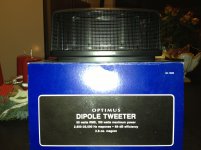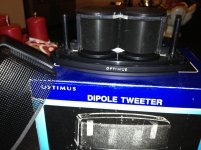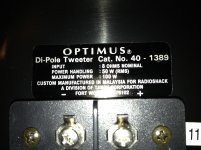Something a bit new, the Linear Motion Transformer from Swiss company Rowen.
ROWEN - Linear Motion Transformer - LMT
The company also has a four-octaves midrange.
ROWEN - 4 octaves midrange driver
From the 6moons site, a bit of bumph on the LMT
Swiss Rowen electronics and speaker brand introduces a new mid/treble transducer called LMT. Unlike air-motion transformers, the LMT doesn't work with diaphragm surface deformation. "A completely linear-motion cellulose membrane without mechanical suspension is driven from four powerful neodymium magnets with a combined pull power of 140kg and an embedded but not fixed twin voice coil. This driver covers 5 octaves. The physical shape of the membrane limits activation in the longitudinal direction and there is no mechanical transmission to moving parts."
Anyone have any addition information on or experience with this?
ROWEN - Linear Motion Transformer - LMT
The company also has a four-octaves midrange.
ROWEN - 4 octaves midrange driver
From the 6moons site, a bit of bumph on the LMT
Swiss Rowen electronics and speaker brand introduces a new mid/treble transducer called LMT. Unlike air-motion transformers, the LMT doesn't work with diaphragm surface deformation. "A completely linear-motion cellulose membrane without mechanical suspension is driven from four powerful neodymium magnets with a combined pull power of 140kg and an embedded but not fixed twin voice coil. This driver covers 5 octaves. The physical shape of the membrane limits activation in the longitudinal direction and there is no mechanical transmission to moving parts."
Anyone have any addition information on or experience with this?
Nope and nope, no idea. Guessing they probably wont make it available for DIY either. And if so, likely to be expensivo, especially as it's Swiss.
Not that I've asked any of these questions. Seems to me as though it is a development of the AMT, though I'm no engineer. Looks to be dipole though.
Not that I've asked any of these questions. Seems to me as though it is a development of the AMT, though I'm no engineer. Looks to be dipole though.
"As to the LMT tech itself, it uses NATURAL not synthetic material and extensive testing (3 years) bears out the superiority of this approach. It runs dipole, but is damped at the back and sound tunnelled back to the front of the speaker. It is very fast like the AMT drivers and you hear this in piano reproduction, but he claims that the extra advantage is that there is no material coloration from using synthetic material like Mylar or Kapton."
Sounds like an advertisement of a new form of "Ecologal" product. Soon we will start to see automobile tires made of wood and being advertised not having "synthetic softness" of rubber...
Sounds like an advertisement of a new form of "Ecologal" product. Soon we will start to see automobile tires made of wood and being advertised not having "synthetic softness" of rubber...
ROWEN - Linear Motion Transformer - LMTIf you look at the movie at the bottom of the page you will se it.
Something new! As far as I can see from that video the membrane is a half of a cardboard cylinder which is attached to the front grid by a longitudinal foam strip. The longitudinal voice coil is attached to the edges of this half cylinder.
So I can not understand some their claims: no mechanical suspension and no surface deformation.
I played around with a similar concept some years ago but my problem was surface deformation and resulting resonances.
It would be very interesting to understand more about this wide frequency transducer including how it is suspended and also see some measurements!
So I can not understand some their claims: no mechanical suspension and no surface deformation.
I played around with a similar concept some years ago but my problem was surface deformation and resulting resonances.
It would be very interesting to understand more about this wide frequency transducer including how it is suspended and also see some measurements!
so it is an inside out Lineaum driven from the outer edges rather than the centre it's a more expensive way to do the same thing and what the diaphragm is made of matters not as far as the design goes. You can find the lineaum designs on google patent search and see all the possible variations. I think that a silk screed diaphragm would work much better than the original plastic foil as it would have a great amount of internal loss. It's a new version of an old design. the basic rat shack tweeter is a very good one despite the low cost. I still have a new pair I got to run with some panels but never used, the are a very good looking tweeter in the cool mesh cage. Best regards Moray James.
Something new! As far as I can see from that video the membrane is a half of a cardboard cylinder which is attached to the front grid by a longitudinal foam strip. The longitudinal voice coil is attached to the edges of this half cylinder.
So I can not understand some their claims: no mechanical suspension and no surface deformation.
I played around with a similar concept some years ago but my problem was surface deformation and resulting resonances.
It would be very interesting to understand more about this wide frequency transducer including how it is suspended and also see some measurements!
I also thought the foam strip is what holds the diaphragm in place at first. However as you say that contradicts what they said in writing about no surface deformation. At 1:04 it sure looks like the foam strip is butted right up to if not attached to the grill itself. Also at 1:20 in the video the yellow arrows seem to show the diaphragm moving forward and back in a linear fashion like a dome tweeter would. Then at 1:25 the arrows seem to indicate a Lineaum type of motion? Would be nice to see a translated video.
Last edited:
I also have a pair of Linaeum tweeters from OPTIMUS. They were used in Radioshak loudspeakers (like the LX5). The design was made by Paul Paddock, all the patents are available on the net. Please Morray James can you explain in plain English what are "silk screed diaphragms" ?...
Attachments
- Status
- This old topic is closed. If you want to reopen this topic, contact a moderator using the "Report Post" button.
- Home
- Loudspeakers
- Planars & Exotics
- Linear motion transformer


